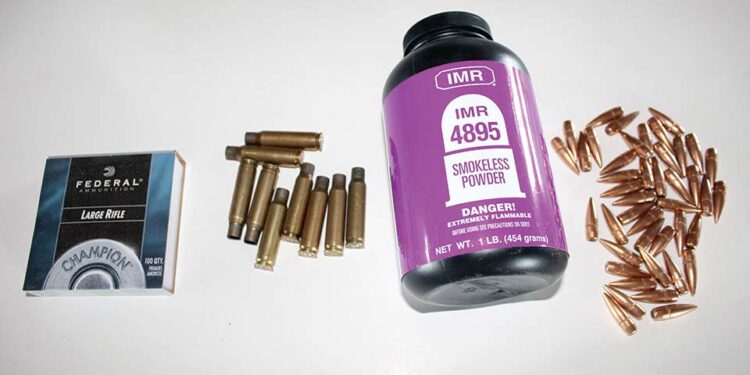Story & Photography by Seth R. Nadel
Reloading—taking a fired cartridge case, reforming it, replacing the primer, powder and bullet, and shooting it again. Most folks do not know that reloading was first widespread by the U.S. Army. As always, logistics was a big issue after the Civil War, with the adoption of the breech-loading rifle. Our first breechloaders were muzzleloaders, converted to load from the back. As they were issued out to the troops on the Western frontier, resupply from the East (St. Louis) took time.
As a result, some ordnance officer, whose name is lost to history, figured out that it took less space to ship lead bars, kegs of powder, primers and one set of reloading tools than case after case of ammunition. The ordnance folks always want to save money, so recycling the cases (in the recycled guns) was a good idea. When you get supplies perhaps once a month—IF the wagons got through—running out of ammo is not an option.
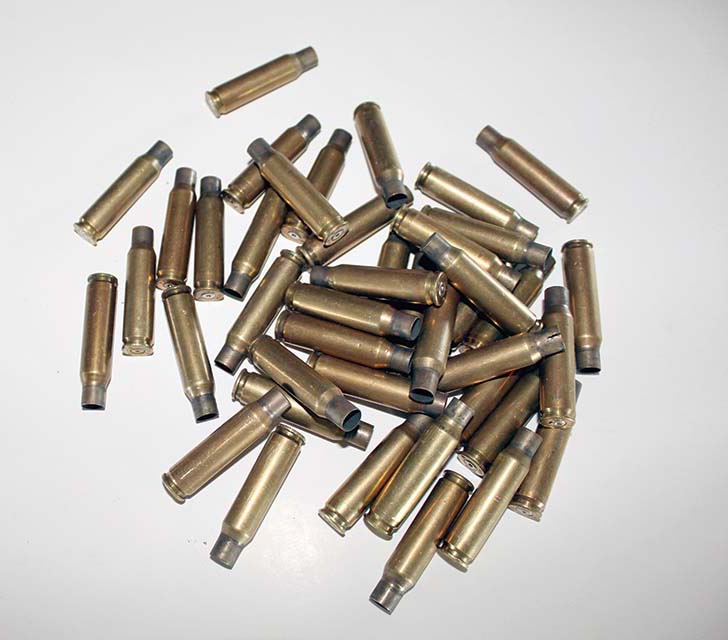
How Is It Done?
These days, the reloading process is pretty much the same as it was in the 1870s. Obtain some cases; clean them; reshape the case; remove the old primer; place a new primer; add a measured powder charge; place the bullet in the case; fire the round again. It is cost-effective—about half the cost of factory ammo. But here is the secret the folks who make reloading tools don’t talk about: You don’t save any money! You shoot twice as much!
Yup, for the price of 50 rounds of ammo, you now have 100! Yee Haw! As this is written, guns and ammo are disappearing from gun shops so fast that most shops limit how much you can buy; maybe 1 or 2 boxes! They make toilet paper seem to be readily available! While the components can be hard to find, they are out there and still cheaper than factory ammo.
Reloading is efficient—in addition to expanding your ammo per dollar, it does not take much time. Even with a single-station press that does one operation at a time, by loading in batches you will never miss a practice session, match or hunt because you do not have any ammo. If it’s too cold, hot or wet to go shooting (it’s hard to believe, but some folks feel that way), you can always load some more ammo!
Fun? That too! When the author has a knotty problem to work out or is irritated about something, he’ll start focusing on loading some ammo and usually work out an answer or work off irritation and get a better perspective on things. Plus, one gets to fine tune the load for his or her particular firearm and objective. There is personal satisfaction at making that difficult shot with ammunition you built yourself. When the steel “clangs” at over 1,000 yards, or the holes in a target are all tightly grouped, there is extra pride in knowing YOU made those rounds.
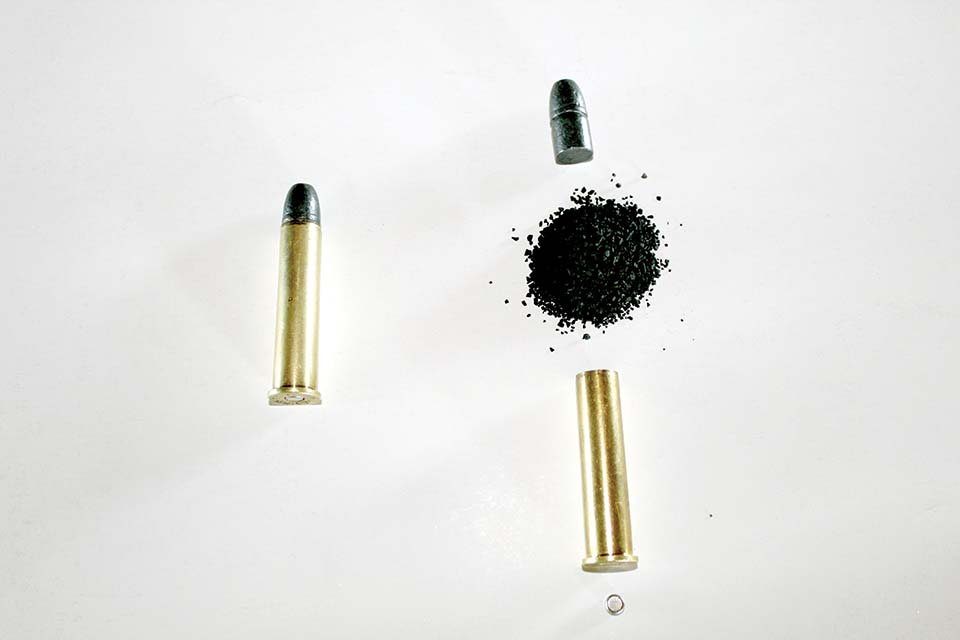
Increase Your Versatility
Do you want to introduce someone new to shooting? Load up some reduced charges for less blast and recoil, so they can focus on the fundamentals. Want to see how accurate a rifle or pistol is? Try different loads to find that sweet spot of maximum accuracy. It’s all there to experiment with. There are folks who buy a box or more of every brand of ammunition in their preferred bullet weight in their chosen caliber and then spend hours carefully trying to figure out which is the most accurate in their rifle or pistol. They end up spending a lot of money creating an inventory of partial boxes of ammo that are inaccurate for their purpose.
A reloader can choose a bullet weight and powder and then load a few rounds with each of several different powder charges and in one range session figure out what load works best in his/her firearm. They can try different brands of powder and bullets by different makers to see the effect on their group size. If the finest precision is their pursuit, they can then further refine their load, until every shot goes into a tiny group. Others want a capable load at the least expense so they can produce lots of ammo for practice and/or competition. Shooting is a perishable skill, and practice is the key to skill maintenance and enhancement.
Then there are those fascinated by older guns in calibers no longer produced. A reloader can obtain the necessary dies to load just about anything, so that antique family heirloom can go out to the range and let its owner feel what it was like “back in the day.” There are even ways to make cartridge cases from existing models to revitalize that oddball round.
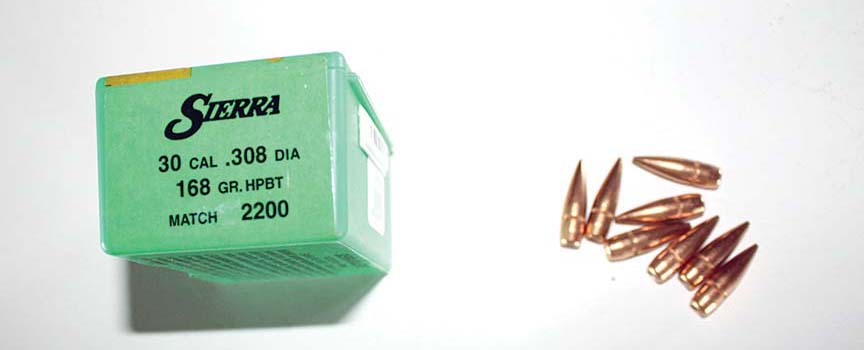
Our focus will be on rifle and pistol ammunition, as reloading shotgun shells is not as cost-effective. Of course, for some bird hunters and shotgun sports competitors, the sheer volume of shooting brings on economies of scale, justifying reloading their hulls.
Some of the readers own full-auto firearms, and the days of inexpensive bulk surplus ammo are long gone. But you can keep those hungry guns fed by reloading. In fact, one reloading tool company was founded because the inventor wanted to shoot his machine guns more than his budget could allow!
Whatever your shooting goals—excellence in competition, meat in the freezer or shooting some gun in an obsolete caliber—learning to reload opens new vistas for the hobbyist, collector or general gun owner.
Getting Started
There are some upfront costs to be considered. These are one-time costs for the tools needed: mainly, reloading manuals; a means of cleaning the cases; a press for reforming the cases and seating the bullets; the dies for your caliber(s); a powder measure to dispense the charges of powder; and a scale to measure the charge weight. There are ways to save money here as used equipment shows up in gun shops, and almost all of it has more life left. It is not uncommon to see presses from the ‘50s still turning out quality ammo.
One decision to be made early on is how much shooting you do or will want to do. Most folks start out with a single-station press, meaning it allows one operation at a time, with the dies changed between operations. Large volume shooters may choose to dive in with a progressive press—a manually operated press that, once fed cases, primers, powder and bullets, will produce a round for every pull of the handle. Rates of 300 to 600 rounds per hour are easily attained if you have settled on one particular load.
One of the oddities of reloading is the multiple ways to get the job done. For every operation in reloading, you can find multiple ways to do it. You will prefer some and discard others, depending on the degree of precision you desire, the volume of ammunition you want to shoot and the differing calibers you may want to reload.
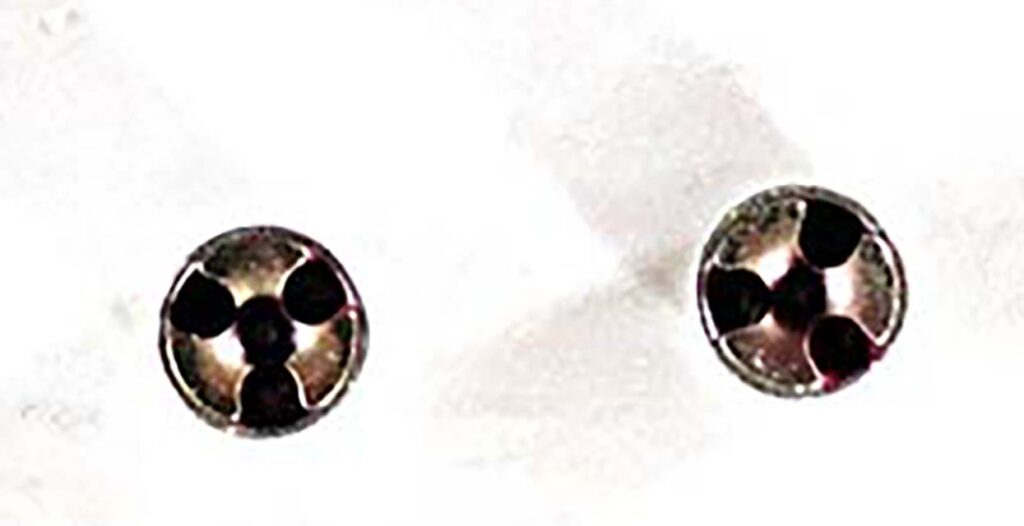
COMPONENTS
Cases
Cases are the best starting point, as they hold the other components together. They can be made of brass, steel, aluminum or plastic. With a sole exception, the steel cases are not reloadable. One company makes a case of stainless steel and aluminum which can be reloaded using special tools. Aluminum and plastic cases are not reloadable. Considering the stresses of high pressures, heat and rough handling, brass has proven to be the best material for reloadable cases.
There are three principal sources of cases—new unloaded cases, the cases from factory ammunition and “range pickup” cases. Those shooting either in high-end competitions at the highest levels or trying to put every bullet through the same hole will buy bags of cases direct from the makers. They will track the number of times the cases are reloaded and trimmed (more about this later) and discard them at a given point. This is the most expensive source. If you have been shooting factory-loaded ammunition, you have “once-fired” brass, all from the same lot; that would be a remarkably close match to the “from the maker” brass. You have already paid for it, so your additional cost is zero.
Most shooters use range pickup brass—which is exactly what it sounds like. Range pickup brass is usually free or can be purchased for a very nominal cost, but there are some disadvantages. It will not be as uniform if absolute precision is your goal; it may have sand, dirt and/or rocks in it. It will need to be sorted in a general way for two specific issues: primer type and origin.
Europe adopted a primer type developed by U.S. General Berdan, where the anvil is part of the case. These have two flash holes inside the case, offset from the center. They can be reloaded, but it is a very messy and slow job, perfected by Europeans with depriming, using hydraulic or pneumatic pressure. Unless it is in a rare caliber, like 7.62×45, it is not worth the trouble. The U.S. adopted a primer system invented by Edward Mounier Boxer, where the anvil is part of the primer, and the case has a central flash hole. These are easy to de-prime, and most are suitable for reloading.
As you gather the brass, once you identify any brass with the Berdan priming, look at the headstamp—the markings on the base of the cartridge. It is simple enough to discard all the cases with that headstamp. As you look at the headstamp, look to see if the caliber is marked there. Commercial brass will always have the caliber, the name or initials of the maker or some other distinguishing mark. There are several books cataloging makers’ marks if interested. If the case is a military origin, there will be no caliber marking, but usually two digits for the year and a letter or number maker code. If it was made to NATO standards, it will have a circle with a cross in it, the NATO symbol.
What is the difference in the brass? Military brass is usually thicker to withstand the rough handling in the gun of fully automatic fire. As a result, it has less interior volume and can generate higher pressures than the same load in commercial brass.
As you pick up the brass, shake it in your hand. If you hear a high musical note, there is one or more cracked cases in that group. Discard all cracked cases, even if the crack is tiny and just in the mouth of the case. The crack could allow the bullet to seat too deeply during the loading cycle, massively increasing the pressure—perhaps to unsafe levels. You will also need to sort the brass by caliber—remove the .380 brass from the 9mm, 8mm from .30-06, .38 SPL from the .357 Magnum, etc. They can look the same but be very different. Continue to check the brass every time you handle it, weeding out the wrong and cracked cases.
The next step in processing the brass is to clean it—no matter the source. The author had some “fresh from the maker” brass, which still had some oil on it from the manufacturing process. Even the first round fired in your clean gun needs to be cleaned, as some of the products of combustion will cover the exterior of the case. You can use a rotary tumbler, a vibratory cleaner or an ultrasonic bath, each with advantages and disadvantages.
Primers
Primers are the ignition tools for ammunition. They contain a tiny amount of an impact-sensitive explosive, which shoots sparks into the powder charge, which then burns. Primers come in two sizes, large and small, in two types, rifle and pistol, and a variety of special uses—regular, magnum, Match, Benchrest and others.
The large and small deal with the size of the primer. In pistols, large cases usually take large primers, which contain more priming compound to set off the large powder charges. Rounds such as .44 Special, .44 Magnum, .45 ACP or .45 “Long” Colt take large primers. 9mm, .38 Special, .357 Magnum and the like take small primers. Your reloading manual will direct which size you need.
Some powders have deterrent coatings to slow the burn rate and take Magnum primers to insure uniform ignition. Again, the loading tables will note which kind of primers were used for which powders. The Match and benchrest primers are made with closer tolerances and greater uniformity and generally cost more.
Both rifle and pistol primers are the same size in large and small. In order to avoid confusion, the author uses one make with nickel-plated cups for rifle loads and a different make with copper-colored cups for pistol loads. The cups for rifle loads are thicker, to withstand the high pressures in rifles. Loading a rifle primer into a pistol case may cause a misfire. Loading a pistol primer into a rifle case may result in a pierced primer and all that high-pressure gas flowing into the action of your rifle and into your face—definitely NOT RECOMMENDED!
Where I’ve Been and Where I’m Going
The author began reloading in the 1960s and continues to reload about 10,000 rounds per year. He loads for 16 different calibers (both rifle and pistol) on both single-station and progressive tools. He has been a professional reloader and is an NRA-certified reloading instructor. His next Small Arms Review installment will cover powders, bullet selection and putting it all together!
| This article first appeared in Small Arms Review V24N8 (Oct 2020) |



